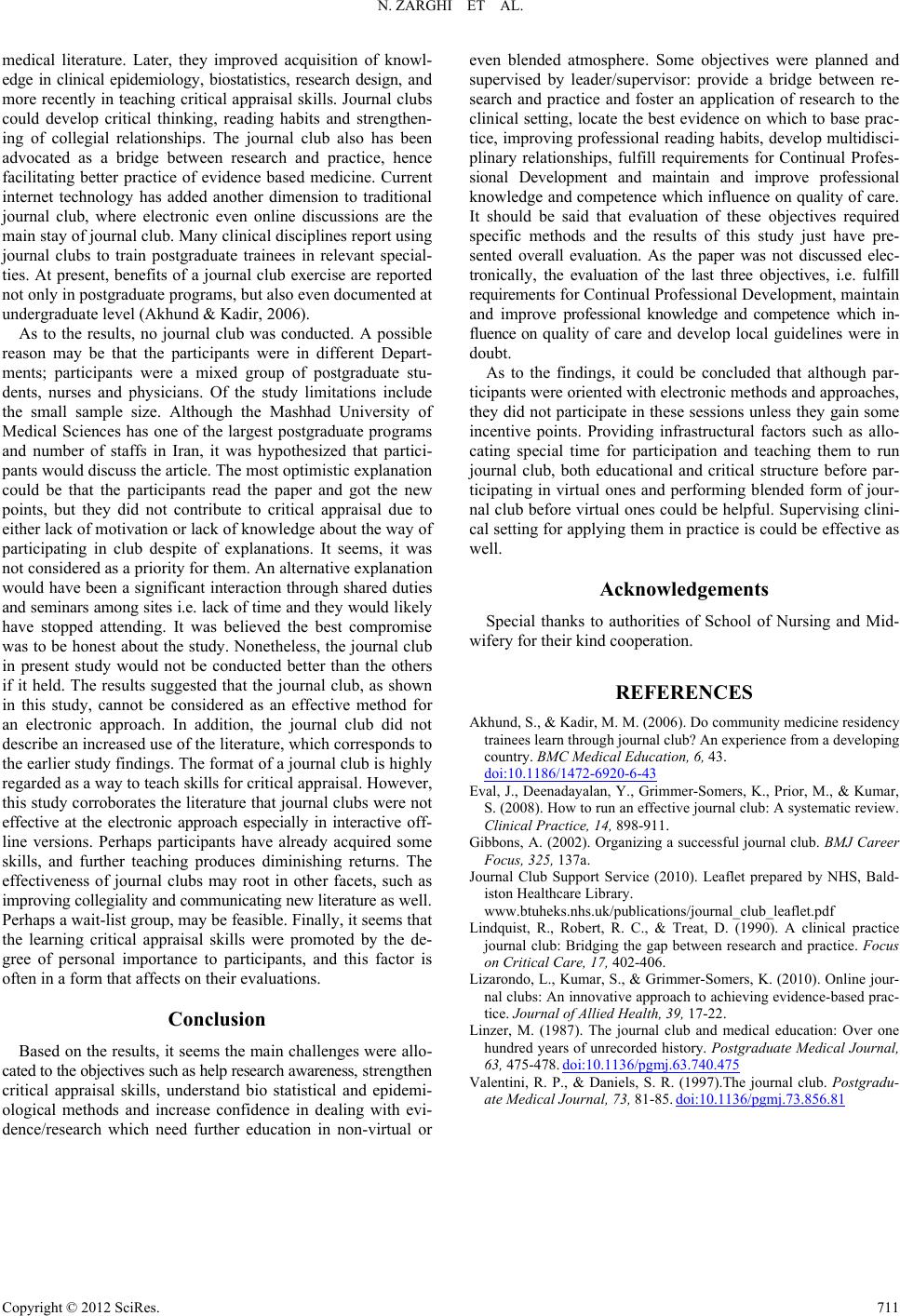
N. ZARGHI ET AL.
medical literature. Later, they improved acquisition of knowl-
edge in clinical epidemiology, biostatistics, research design, and
more recently in teaching critical appraisal skills. Journal clubs
could develop critical thinking, reading habits and strengthen-
ing of collegial relationships. The journal club also has been
advocated as a bridge between research and practice, hence
facilitating better practice of evidence based medicine. Current
internet technology has added another dimension to traditional
journal club, where electronic even online discussions are the
main stay of journal club. Many clinical disciplines report using
journal clubs to train postgraduate trainees in relevant special-
ties. At present, benefits of a journal club exercise are reported
not only in postgraduate programs, but also even documented at
undergraduate level (Akhund & Kadir, 2006).
As to the results, no journal club was conducted. A possible
reason may be that the participants were in different Depart-
ments; participants were a mixed group of postgraduate stu-
dents, nurses and physicians. Of the study limitations include
the small sample size. Although the Mashhad University of
Medical Sciences has one of the largest postgraduate programs
and number of staffs in Iran, it was hypothesized that partici-
pants would discuss the article. The most optimistic explanation
could be that the participants read the paper and got the new
points, but they did not contribute to critical appraisal due to
either lack of motivation or lack of knowledge about the way of
participating in club despite of explanations. It seems, it was
not considered as a priority for them. An alternative explanation
would have been a significant interaction through shared duties
and seminars among sites i.e. lack of time and they would lik ely
have stopped attending. It was believed the best compromise
was to be honest about the study. Nonetheless, the journal club
in present study would not be conducted better than the others
if it held. The results suggested that the journal club, as shown
in this study, cannot be considered as an effective method for
an electronic approach. In addition, the journal club did not
describe an increased use of the literature, which corresponds to
the earlier study findings. The format of a journal club is highly
regarded as a way to teach skills for critical appraisal. However,
this study corroborates the literature that journal clubs were not
effective at the electronic approach especially in interactive off-
line versions. Perhaps participants have already acquired some
skills, and further teaching produces diminishing returns. The
effectiveness of journal clubs may root in other facets, such as
improving collegiality and communicating ne w lit erature as w e ll.
Perhaps a wait-list group, may be feasible. Finally, it seems that
the learning critical appraisal skills were promoted by the de-
gree of personal importance to participants, and this factor is
often in a form that affects on their evaluations.
Conclusion
Based on the results, it seems the main challenges were allo-
cated to the objectives such as help research awareness, streng then
critical appraisal skills, understand bio statistical and epidemi-
ological methods and increase confidence in dealing with evi-
dence/research which need further education in non-virtual or
even blended atmosphere. Some objectives were planned and
supervised by leader/supervisor: provide a bridge between re-
search and practice and foster an application of research to the
clinical setting, locate the best evidence on which to base prac-
tice, improving professional reading habits, develop multidisci-
plinary relationships, fulfill requirements for Continual Profes-
sional Development and maintain and improve professional
knowledge and competence which influence on quality of care.
It should be said that evaluation of these objectives required
specific methods and the results of this study just have pre-
sented overall evaluation. As the paper was not discussed elec-
tronically, the evaluation of the last three objectives, i.e. fulfill
requirements for Continual Professional Development, maintain
and improve professional knowledge and competence which in-
fluence on quality of care and develop local guidelines were in
doubt.
As to the findings, it could be concluded that although par-
ticipants were oriented with electronic methods and approaches,
they did not participate in these sessions unless they gain some
incentive points. Providing infrastructural factors such as allo-
cating special time for participation and teaching them to run
journal club, both educational and critical structure before par-
ticipating in virtual ones and performing blended form of jour-
nal club before virtual ones could be helpful. Supervising clini-
cal setting for applying them in practice is could be effective as
well.
Acknowledgements
Special thanks to authorities of School of Nursing and Mid-
wifery for their kind cooperation.
REFERENCES
Akhund, S., & Kadir, M. M. (2006). Do community medicine residency
trainees learn thr ough journal club? An experie nc e f rom a developing
country. B M C Medical E d uca ti on, 6, 43.
doi:10.1186/1472-6920-6-43
Eval, J., Deenadayalan, Y., G rimme r-Some rs, K., Prior, M., & Kumar,
S. (2008). How to run an effective journal club: A systematic review.
Clinical Practice, 14, 898-911.
Gibbons, A. (2002). Organizing a successful journal club. BMJ Career
Focus, 325, 137a.
Journal Club Support Service (2010). Leaflet prepared by NHS, Bald-
iston Healthcare Library.
www.btuheks.nhs.uk/publications/journal_club_leaflet.pdf
Lindquist, R., Robert, R. C., & Treat, D. (1990). A clinical practice
journal club: Bridging the gap between research and practice. Focus
on Critical Care, 17, 402-406.
Lizarondo, L., Kumar, S., & Grimmer-Somers, K. (2010). Online jour-
nal clubs: An innovative approach to achieving evidence-based prac-
tice. Journal of Allied Health, 39 , 17-22.
Linzer, M. (1987). The journal club and medical education: Over one
hundred years of unrecorded history. Postgraduate Medical Journal,
63, 475-478. doi:10.1136/pgmj.63.740.475
Valentini, R. P., & Daniels, S. R. (1997).The journal club. Postgradu-
ate Medical Journal, 73, 81-85. doi:10.1136/pgmj.73.856.81
Copyright © 2012 SciRe s . 711